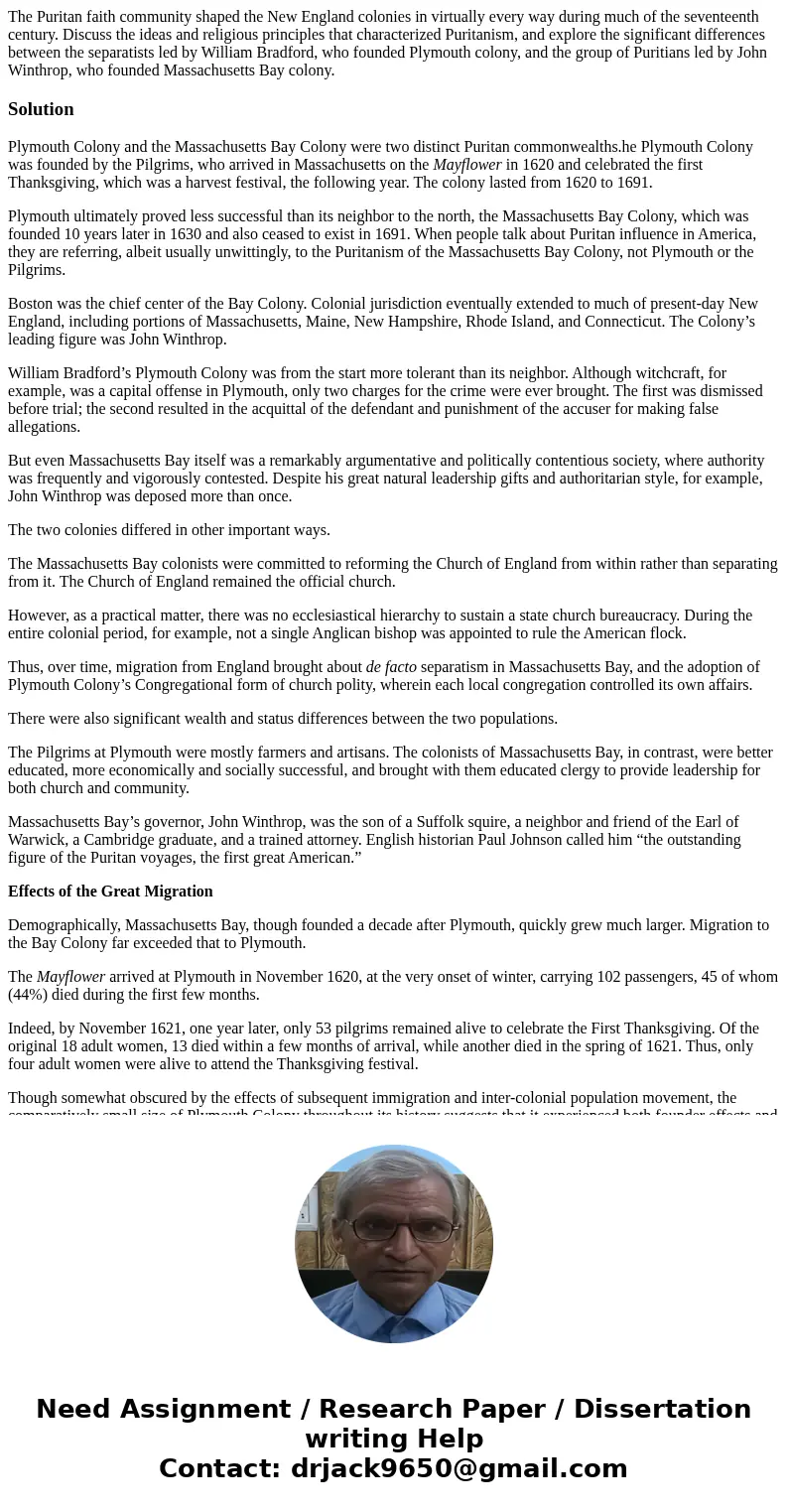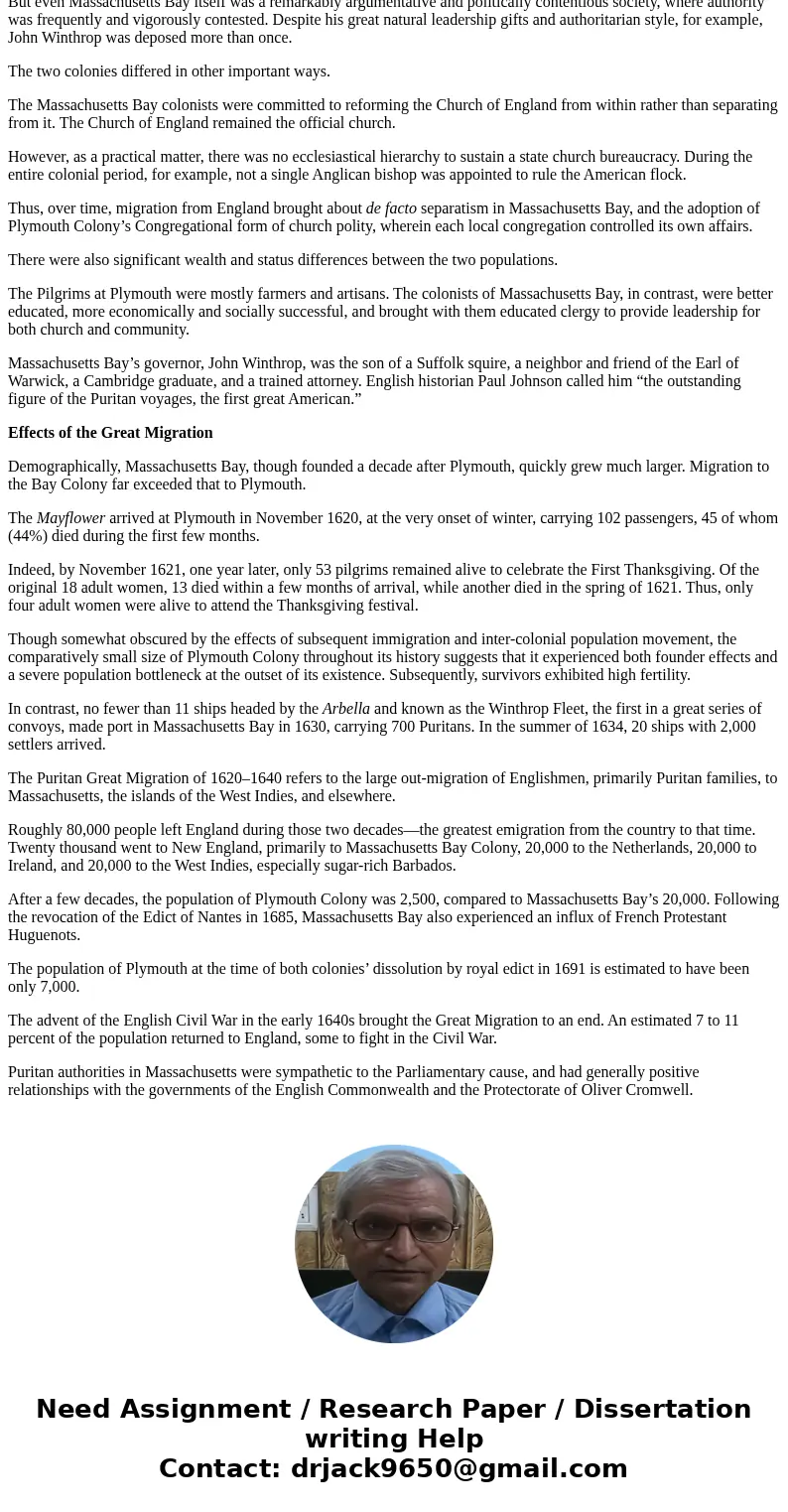The Puritan faith community shaped the New England colonies
The Puritan faith community shaped the New England colonies in virtually every way during much of the seventeenth century. Discuss the ideas and religious principles that characterized Puritanism, and explore the significant differences between the separatists led by William Bradford, who founded Plymouth colony, and the group of Puritians led by John Winthrop, who founded Massachusetts Bay colony.
Solution
Plymouth Colony and the Massachusetts Bay Colony were two distinct Puritan commonwealths.he Plymouth Colony was founded by the Pilgrims, who arrived in Massachusetts on the Mayflower in 1620 and celebrated the first Thanksgiving, which was a harvest festival, the following year. The colony lasted from 1620 to 1691.
Plymouth ultimately proved less successful than its neighbor to the north, the Massachusetts Bay Colony, which was founded 10 years later in 1630 and also ceased to exist in 1691. When people talk about Puritan influence in America, they are referring, albeit usually unwittingly, to the Puritanism of the Massachusetts Bay Colony, not Plymouth or the Pilgrims.
Boston was the chief center of the Bay Colony. Colonial jurisdiction eventually extended to much of present-day New England, including portions of Massachusetts, Maine, New Hampshire, Rhode Island, and Connecticut. The Colony’s leading figure was John Winthrop.
William Bradford’s Plymouth Colony was from the start more tolerant than its neighbor. Although witchcraft, for example, was a capital offense in Plymouth, only two charges for the crime were ever brought. The first was dismissed before trial; the second resulted in the acquittal of the defendant and punishment of the accuser for making false allegations.
But even Massachusetts Bay itself was a remarkably argumentative and politically contentious society, where authority was frequently and vigorously contested. Despite his great natural leadership gifts and authoritarian style, for example, John Winthrop was deposed more than once.
The two colonies differed in other important ways.
The Massachusetts Bay colonists were committed to reforming the Church of England from within rather than separating from it. The Church of England remained the official church.
However, as a practical matter, there was no ecclesiastical hierarchy to sustain a state church bureaucracy. During the entire colonial period, for example, not a single Anglican bishop was appointed to rule the American flock.
Thus, over time, migration from England brought about de facto separatism in Massachusetts Bay, and the adoption of Plymouth Colony’s Congregational form of church polity, wherein each local congregation controlled its own affairs.
There were also significant wealth and status differences between the two populations.
The Pilgrims at Plymouth were mostly farmers and artisans. The colonists of Massachusetts Bay, in contrast, were better educated, more economically and socially successful, and brought with them educated clergy to provide leadership for both church and community.
Massachusetts Bay’s governor, John Winthrop, was the son of a Suffolk squire, a neighbor and friend of the Earl of Warwick, a Cambridge graduate, and a trained attorney. English historian Paul Johnson called him “the outstanding figure of the Puritan voyages, the first great American.”
Effects of the Great Migration
Demographically, Massachusetts Bay, though founded a decade after Plymouth, quickly grew much larger. Migration to the Bay Colony far exceeded that to Plymouth.
The Mayflower arrived at Plymouth in November 1620, at the very onset of winter, carrying 102 passengers, 45 of whom (44%) died during the first few months.
Indeed, by November 1621, one year later, only 53 pilgrims remained alive to celebrate the First Thanksgiving. Of the original 18 adult women, 13 died within a few months of arrival, while another died in the spring of 1621. Thus, only four adult women were alive to attend the Thanksgiving festival.
Though somewhat obscured by the effects of subsequent immigration and inter-colonial population movement, the comparatively small size of Plymouth Colony throughout its history suggests that it experienced both founder effects and a severe population bottleneck at the outset of its existence. Subsequently, survivors exhibited high fertility.
In contrast, no fewer than 11 ships headed by the Arbella and known as the Winthrop Fleet, the first in a great series of convoys, made port in Massachusetts Bay in 1630, carrying 700 Puritans. In the summer of 1634, 20 ships with 2,000 settlers arrived.
The Puritan Great Migration of 1620–1640 refers to the large out-migration of Englishmen, primarily Puritan families, to Massachusetts, the islands of the West Indies, and elsewhere.
Roughly 80,000 people left England during those two decades—the greatest emigration from the country to that time. Twenty thousand went to New England, primarily to Massachusetts Bay Colony, 20,000 to the Netherlands, 20,000 to Ireland, and 20,000 to the West Indies, especially sugar-rich Barbados.
After a few decades, the population of Plymouth Colony was 2,500, compared to Massachusetts Bay’s 20,000. Following the revocation of the Edict of Nantes in 1685, Massachusetts Bay also experienced an influx of French Protestant Huguenots.
The population of Plymouth at the time of both colonies’ dissolution by royal edict in 1691 is estimated to have been only 7,000.
The advent of the English Civil War in the early 1640s brought the Great Migration to an end. An estimated 7 to 11 percent of the population returned to England, some to fight in the Civil War.
Puritan authorities in Massachusetts were sympathetic to the Parliamentary cause, and had generally positive relationships with the governments of the English Commonwealth and the Protectorate of Oliver Cromwell.


 Homework Sourse
Homework Sourse